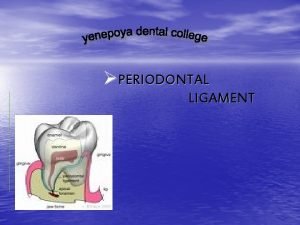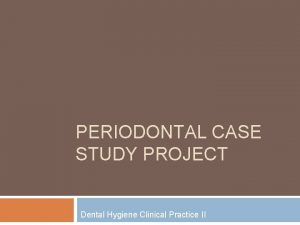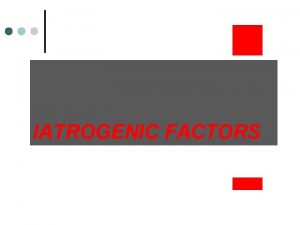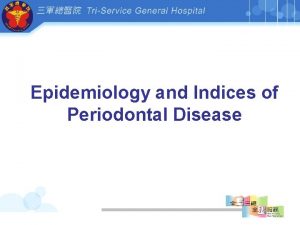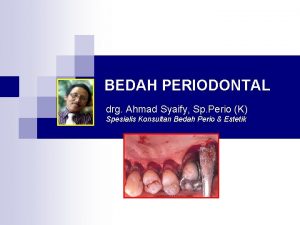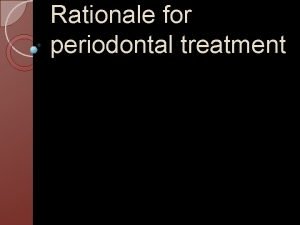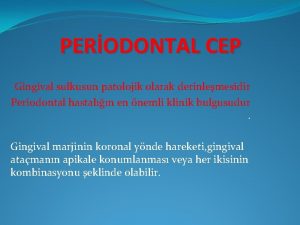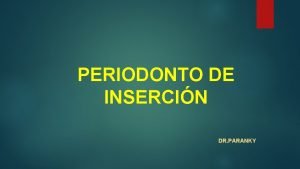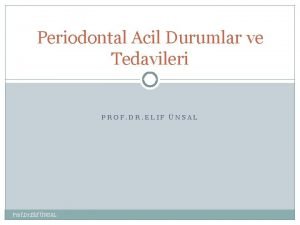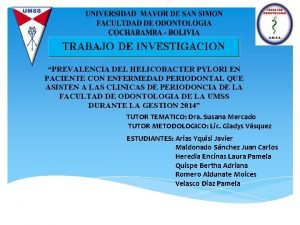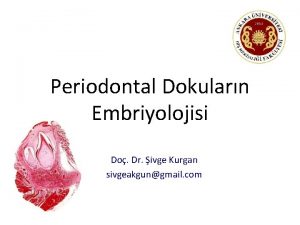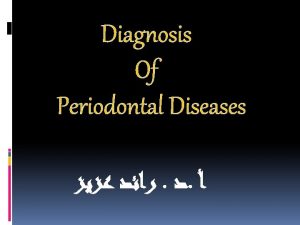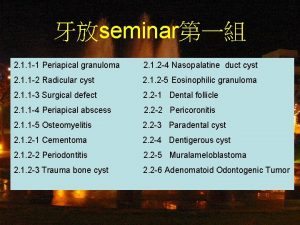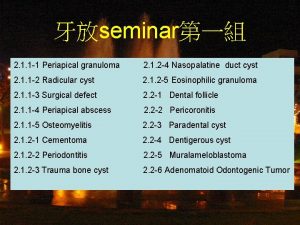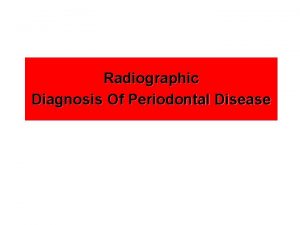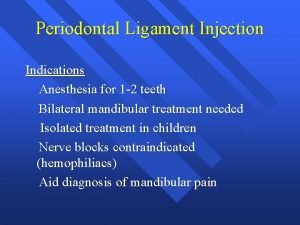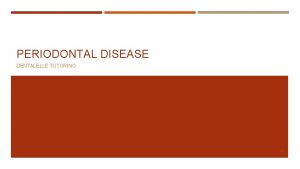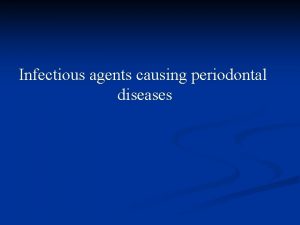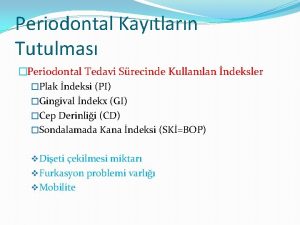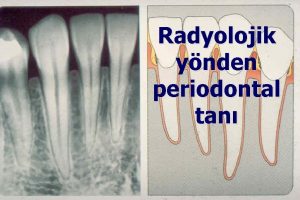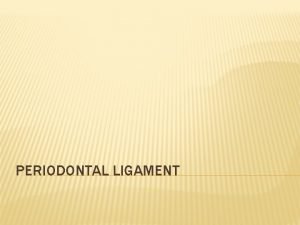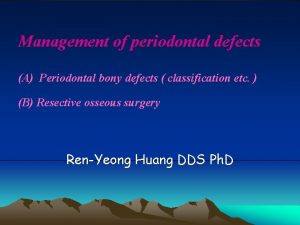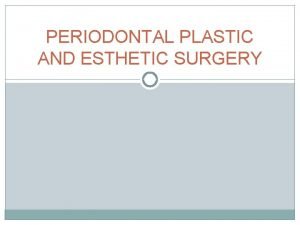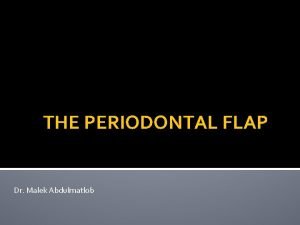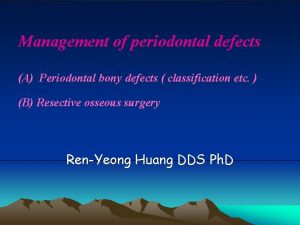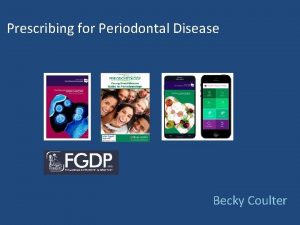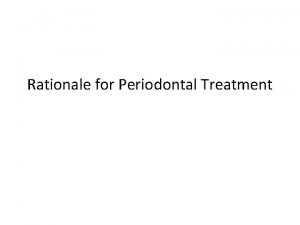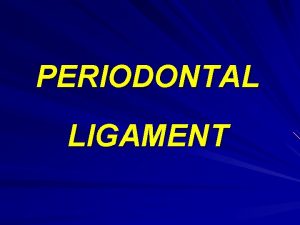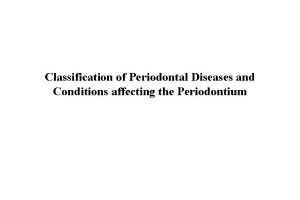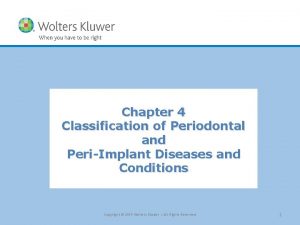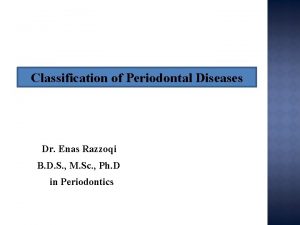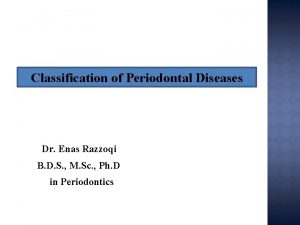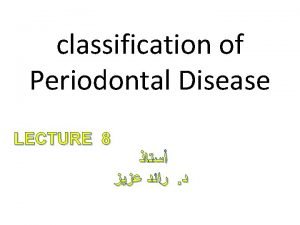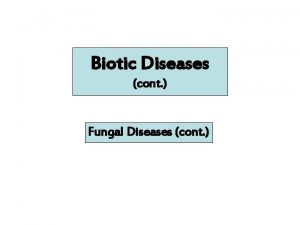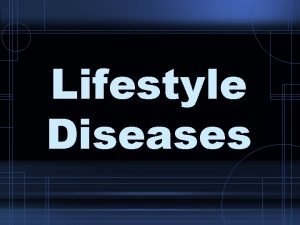Classification of Periodontal Diseases Why Classification Helps in




























- Slides: 28

Classification of Periodontal Diseases

Why Classification ? ØHelps in the development of frameworks to study the I. aetiology, II. Pathogenesis & III. treatment of diseases; Ø Provides the international healthcare community with a way of communicating in a common language.

Where we? Ø juvenile periodontitis (prepubertal, localized and generalized); Ø early-onset periodontitis (formally prepubertal, juvenile and rapidly progressive); Øadult periodontitis; ( This classification system is heavily age dependent: a cut-off point of 35 Years) Øacute necrotizing ulcerative periodontitis; Ø refractory periodontitis.

Periapical radiographs of a 36 -year-old patient, showing severe generalized bone loss. Diagnosis: ‘chronic adult periodontitis’ or ‘early-onset periodontitis’?

Where are we now? The following changes were implemented: Ø Gingival disease category introduced. Ø ‘Adult periodontitis’ replaced by ‘chronic periodontitis’. Ø ‘Refractory disease’ category removed. Ø ‘Early-onset periodontitis’ replaced by ‘aggressive periodontitis’. Ø The implications of systemic diseases on periodontal status were expanded and more comprehensively defined. Ø ‘Necrotizing periodontal diseases’ were introduced to cover both ‘necrotizing periodontitis’ and ‘necrotizing gingivitis’. Ø ‘Periodontal abscess’ and ‘periodontal-endodontic’ lesions were added. Ø A category for developmental or acquired lesions was introduced.

The 1999 International Workshop for the Classification of Gingival Diseases A. Dental plaque-induced gingival diseases B. Non-plaque-induced gingival lesions The 1999 International Workshop for the Classification of Periodontal Diseases. A. Chronic periodontitis B. Aggressive periodontitis C. Periodontitis as a manifestation of systemic diseases D. Necrotizing periodontal diseases E. Abscesses of the periodontium F. Periodontitis associated with endodontic lesions G. Developmental or acquired deformities and conditions

Gingival diseases: A simplified version of the 1999 International Workshop. 5

Classification of Gingival Diseases Dental plaque-induced gingival diseases 1. Gingivitis associated with dental plaque only a. Without other local contributing factors b. With local contributing factors

Classification of Gingival Diseases Dental plaque-induced gingival diseases 2. Gingival diseases modified by systemic factors a. associated with the endocrine system 1) puberty-associated gingivitis 2) menstrual cycle-associated gingivitis 3) pregnancy-associated a) gingivitis b) pyogenic granuloma 4) diabetes mellitus-associated gingivitis b. associated with blood dyscrasias 1) leukaemia-associated gingivitis 2) other

Classification of Gingival Diseases Dental plaque-induced gingival diseases 3. Gingival diseases modified by medications 1) drug-influenced gingival enlargements 2) drug-influenced gingivitis a) oral contraceptive-associated gingivitis b) other 4. Gingival diseases modified by malnutrition a. ascorbic acid-deficiency gingivitis b. other

Classification of Gingival Diseases Non-plaque-induced gingival lesions 1. Gingival diseases of specific bacterial origin a. Neisseria gonorrhoea-associated lesions b. Treponema pallidum-associated lesions c. streptococcal species-associated lesions d. other 2. Gingival diseases of viral origin a. herpesvirus infections 1) primary herpetic gingivostomatitis 2) recurrent oral herpes 3) varicella-zoster infections b. other

Classification of Gingival Diseases Non-plaque-induced gingival lesions 3. Gingival diseases of fungal origin a. candidal infections 1) generalized gingival candidosis b. linear gingival erythema c. histoplasmosis d. other 4. Gingival lesions of genetic origin a. hereditary gingival fibromatosis b. other

Classification of Gingival Diseases Non-plaque-induced gingival lesions 5. Gingival manifestations of systemic conditions a. mucocutaneous disorders 1) lichen planus 2) pemphigoid 3) pemphigus vulgaris 4) erythema multiforme 5) lupus erythematosus 6) drug-induced 7) other b. allergic reactions 1) dental restorative materials a) mercury b) nickel c) acrylic d) other 3) other 2) reactions attributable to a) toothpastes/dentifrices b) mouthrinses/mouthwashes c) chewing gum additives d) foods and additives

Classification of Gingival Diseases Non-plaque-induced gingival lesions 6. Traumatic lesions (factitious, iatrogenic, accidental) a. chemical injury b. physical injury c. thermal injury 7. Foreign body reactions 8. Not otherwise specified (NOS)

Gingival diseases: A simplified version of the 1999 International Workshop. 5

The 1999 International Workshop for the Classification of Gingival Diseases A. Dental plaque-induced gingival diseases B. Non-plaque-induced gingival lesions The 1999 International Workshop for the Classification of Periodontal Diseases. A. Chronic periodontitis B. Aggressive periodontitis C. Periodontitis as a manifestation of systemic diseases D. Necrotizing periodontal diseases E. Abscesses of the periodontium F. Periodontitis associated with endodontic lesions G. Developmental or acquired deformities and conditions

Periodontal diseases: A simplified version of the 1999 International Workshop. 5

Classification of Periodontal Diseases. A. Chronic periodontitis a. Localized : up to 30% of sites b. Generalized : more than 30% of sites Severity of the disease I. Slight: CAL 1– 2 mm. II. Moderate: CAL 3– 4 mm. III. Severe: CAL 5 mm or more. [clinical attachment loss (CAL)]:

Clinical features and characteristics of Chronic Periodontitis: § Most prevalent in adults (but can occur in children and adolescents). § Amount of destruction of the periodontium is consistent with the presence of local risk factors. § Subgingival calculus is a frequent finding. § Slow to moderate of progression (but can have periods of rapid attachment loss). § May be modified by systemic disease. § Can be modified by factors such as smoking and stress.

Classification of Periodontal Diseases. B. Aggressive periodontitis a. Localized. b. Generalized : : § Onset around puberty. § First molar and incisor involvement. § Raised serum antibody response to pathogens. § Usually under 30 years, but does occur in older patients. § Poor antibody response to pathogens. § Pronounced episodic nature of loss of attachment and alveolar bone. § Generalized interproximal attachment loss affecting at least three permanent teeth (other than first molars and incisors).

Classification of Periodontal Diseases. C. Periodontitis as a manifestation of systemic diseases a. Associated with haematological disorders 1. Acquired neutropenia 2. Leukaemias 3. Other b. Associated with genetic disorders 1. Familial and cyclic neutropenia 2. Down’s syndrome 3. Leukocyte adhesion deficiency syndromes 4. Papillon–Lefèvre syndrome 5. Chediak–Higashi syndrome 6. Histiocytosis syndromes 7. Glycogen storage disease 8. Infantile genetic agranulocytosis 9. Cohen syndrome 10. Ehlers–Danlos syndrome (Types IV and VIII) 11. Hypophosphatasia 12. Other c. Not otherwise specified (NOS)

Classification of Periodontal Diseases. D. Necrotizing periodontal diseases a. Necrotizing ulcerative gingivitis (NUG) b. Necrotizing ulcerative periodontitis (NUP) E. Abscesses of the periodontium a. Gingival abscess b. Periodontal abscess c. Pericoronal abscess F. Periodontitis associated with endodontic lesions Combined periodontic-endodontic lesions

Classification of Periodontal Diseases. G. Developmental or acquired deformities and conditions a. Localized tooth-related factors that modify or predispose to plaque-induced gingival diseases/periodontitis 1. Tooth anatomic factors 2. Dental restorations/appliances 3. Root fractures 4. Cervical root resorption and cemental tears

Classification of Periodontal Diseases. G. Developmental or acquired deformities and conditions b. Mucogingival deformities and conditions around teeth 1. Gingival/soft tissue recession a) facial or lingual surfaces b) interproximal (papillary) 2. Lack of keratinized gingiva 3. Decreased vestibular depth 4. Aberrant fraenum/muscle position 5. Gingival excess a) pseudopocket b) inconsistent gingival margin c) excessive gingival display d) gingival enlargement 6. Abnormal colour

Classification of Periodontal Diseases. G. Developmental or acquired deformities and conditions c. Mucogingival deformities and conditions on edentulous ridges 1. Vertical and/or horizontal ridge deficiency 2. Lack of gingiva/keratinized tissue 3. Gingival/soft tissue enlargement 4. Aberrant fraenum/muscle position 5. Decreased vestibular depth 6. Abnormal colour

Classification of Periodontal Diseases. G. Developmental or acquired deformities and conditions d. Occlusal trauma 1. Primary occlusal trauma 2. Secondary occlusal trauma

Periodontal diseases: A simplified version of the 1999 International Workshop. 5

THANK YOU
 Hey bye bye
Hey bye bye Gracey curette classification
Gracey curette classification Definition of periradicular disease
Definition of periradicular disease Dont ask
Dont ask Perimylolysis
Perimylolysis Plak boyayıcı ajan
Plak boyayıcı ajan Periodontal ligaments
Periodontal ligaments Periodontal case study
Periodontal case study Iatrogenic factors in periodontal disease
Iatrogenic factors in periodontal disease Plaque index scoring criteria
Plaque index scoring criteria Fases de la enfermedad periodontal
Fases de la enfermedad periodontal Corrective phase periodontal therapy
Corrective phase periodontal therapy Enap perio
Enap perio Rationale of periodontal treatment
Rationale of periodontal treatment Deskuame
Deskuame Elementos del periodonto
Elementos del periodonto Glickman's concept
Glickman's concept Cva
Cva Akut streptokokal gingivitis
Akut streptokokal gingivitis Lima maestra
Lima maestra Heliprobe 2 positivo
Heliprobe 2 positivo Cushion hammock ligament
Cushion hammock ligament Dişin embriyolojik gelişim evreleri
Dişin embriyolojik gelişim evreleri Diagnosis of periodontal disease
Diagnosis of periodontal disease Non corticated
Non corticated Periapical scar
Periapical scar Periodontal abscess
Periodontal abscess Periodontal ligament injection definition
Periodontal ligament injection definition Periodontal disease
Periodontal disease






